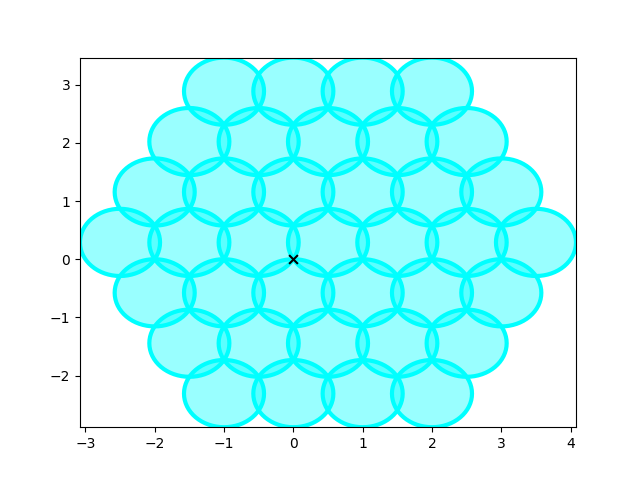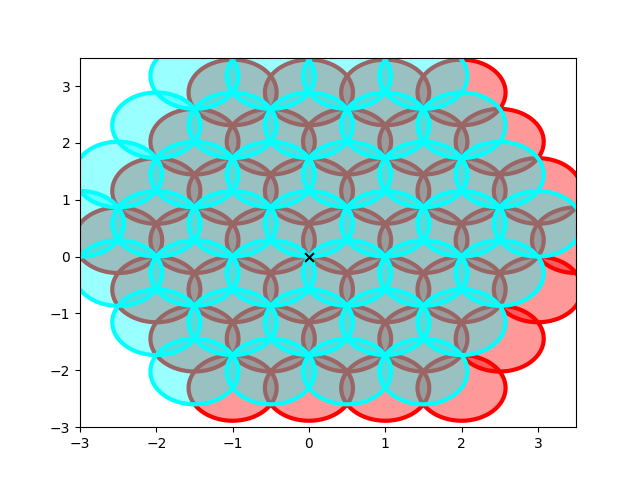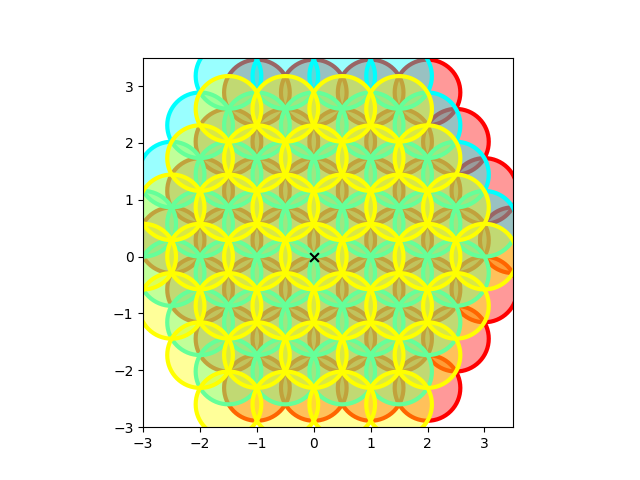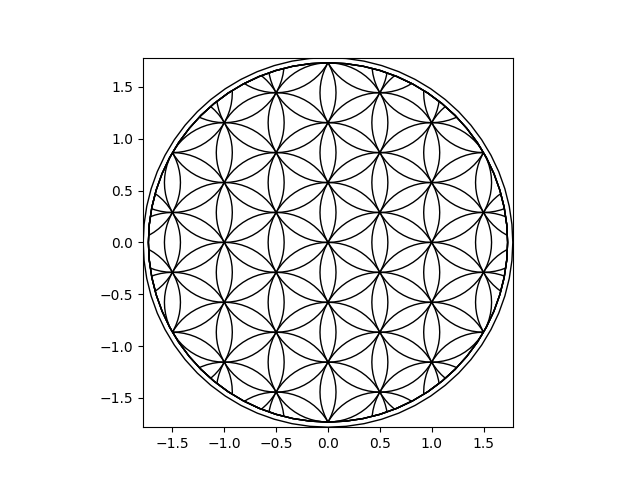Note
Go to the end to download the full example code.
Flower of life
The so called ‘flower of life’ is a type of ‘overlapping circles grid’ seen in many cultures. While it is often constructed on a triangular grid, here I will show how to construct one using three hexagonal grids where their relative offsets and rotation are chosen deliberately to construct the desired pattern.
First I will create an hexagonal grid and plot the cells as circles where the radius will be the distance from the center to a corner.
I will anchor a corner to a chosen center such that it is easier to reason about.
from gridkit import HexGrid
center = [0, 0]
depth = 3
grid = HexGrid(size=1, rotation=0).anchor(center)
def get_centroids(grid):
"""Get the centroids of a collection of cells around the specified 'center'
at a specified depth"""
ids = grid.neighbours(
grid.cell_at_point(center), depth=depth, include_selected=True
)
return grid.centroid(ids)
grid.anchor(center, in_place=True, cell_element="corner")
centroids = get_centroids(grid)
Now I will plot the circles at the obtained centroids.
Tip
The circles are plotted as matplotlib’s PatchCollection objects.
In this script I represent them as shapely Polygons for convenience and reusability,
but they can also be represented using a matplotlib.circle(centroid, radius)
import matplotlib.pyplot as plt
from shapely.geometry import MultiPolygon, Point
from gridkit.doc_utils import plot_polygons
def plot_circles(geoms, color):
plot_polygons(geoms, colors=color, alpha=0.4)
plot_polygons(geoms, colors=color, fill=False, linewidth=3)
radius = grid.r
centroids_to_polygons = lambda centroids: MultiPolygon(
[Point(c).buffer(radius) for c in centroids]
)
circles = centroids_to_polygons(centroids)
plot_circles(circles, "cyan")
plt.scatter(*center, marker="x", color="black", s=40)
plt.show()

If you are familiar with the flower of life pattern, you might find that we are already nicely underway, but we are missing some circles. The first set of circles we might want to add, is basically the same set, but rotated by 60 degrees around the chosen center. This looks like so:
grid.rotation = 60
grid.anchor(
center, in_place=True, cell_element="corner"
) # re-anchor a corner at the chosen center after rotation
centroids1 = get_centroids(grid)
circles1 = centroids_to_polygons(centroids1)
# Plot the two sets of circles
plot_circles(circles, "red")
plot_circles(circles1, "cyan")
plt.scatter(*center, marker="x", color="black", s=40)
ax = plt.gca()
ax.set_xlim(-3, 3.5)
ax.set_ylim(-3, 3.5)
plt.show()

Now we are very close, but still missing some circles. The last set will need to circle the chosen center and not cross it. Let’s add the last set of circles:
grid.anchor(center, in_place=True, cell_element="centroid")
centroids2 = get_centroids(grid)
circles2 = centroids_to_polygons(centroids2)
plot_circles(circles, "red")
plot_circles(circles1, "cyan")
plot_circles(circles2, "yellow")
plt.scatter(*center, marker="x", color="black", s=40)
ax = plt.gca()
ax.set_aspect("equal")
ax.set_xlim(-3, 3.5)
ax.set_ylim(-3, 3.5)
plt.show()

This is it! To visualize it nicely we can add a border around it and clip the polygons such that they do not cross the outer border.
Note
In Shapely<2.1.0 we could do MultiPolygon([c.intersection(outer_poly) for c in all_circles]), but since Shapely 2.1.0 intersection can return a point. We cannot create a MultiPolygon from a list that includes points, hence we have to filter those out manually.
outer_poly = Point(center).buffer(3 * grid.r)
all_circles = [*circles.geoms, *circles1.geoms, *circles2.geoms]
intersected_circles = [c.intersection(outer_poly) for c in all_circles]
all_circles = MultiPolygon([c for c in intersected_circles if not isinstance(c, Point)])
plot_polygons(all_circles, fill=False, colors="black")
plot_polygons(outer_poly.buffer(0.0), fill=False, colors="black")
plot_polygons(outer_poly.buffer(0.05), fill=False, colors="black")
plt.gca().set_aspect("equal")
plt.show()

Total running time of the script: (0 minutes 0.341 seconds)